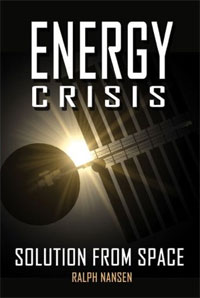Review: Energy Crisisby Jeff Foust
|
| Nansen acknowledges that the “first and biggest stumbling block” to SBSP is the need for low-cost space access. |
Nansen, who worked on some of the early SBSP studies as a Boeing engineer in the 1970s, argues that we’re nearing the end of the third era of energy: oil, which followed wood and coal. Growing demand and diminishing discoveries of new oil supplies will mean that prices will go up and shortages will occur, jeopardizing the economy if not civilization itself. A fourth era of energy must follow oil, but Nansen doesn’t believe that any of the existing alternatives—nuclear, wind, biomass, and terrestrial solar, among others—is sufficient to fill in the looming gap in energy needs as oil supplies dwindle. Only SBSP, he states, fulfills the five criteria he believes are essential to a new energy system: low cost, nondepletable, environmentally clean, available to everyone, and producing energy in a usable form. A bonus, he notes, is that SBSP can also address the looming crisis of anthropogenic global warming created by burning fossil fuels.
Nansen acknowledges that the “first and biggest stumbling block” to SBSP is the need for low-cost space access. He spends one chapter addressing this, suggesting the solution is the development of a two-stage reusable system, most likely by the government, although he argues that it should be done not by NASA but instead by a new agency “that hasn’t had time to develop into a bureaucracy”. (An earlier chapter, titled “What If?”, recounts his work at Boeing on early space shuttle concepts years before he worked on SBSP. The title comes from his belief that the designs he helped develop would have been more likely to realize the cost and flight rate goals for the shuttle program, and thus could have ushered in the SBSP era decades earlier.) The cost would not be cheap—$25 billion, he estimates—but it “would be a wise investment in our future.”
Energy Crisis is focused much more on the why of SBSP than the how: there’s little technical discussion about how SBSP system would work, beyond some basic descriptions, nor much discussion of the other technical and economic issues that SBSP must overcome for it to become reality. That limits the effectiveness of the book as an advocacy tool for SBSP proponents: few people, after all, would argue that we don’t need more sources of energy as the world’s population both grows and modernizes, and that there will be dire consequences if we fail. What isn’t clear is that SBSP, while attractive in general, can overcome the space transportation and other “stumbling blocks” needed for it to emerge as the solution—or even one solution of many. Energy Crisis states the case for SBSP but doesn’t close it: others will have to follow up to answer not just the why questions about SBSP but also the how, if this cycle of interest in the concept is not to die out again.
